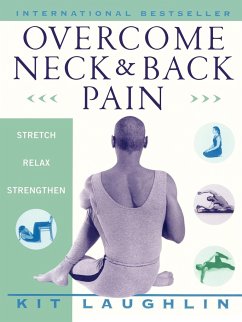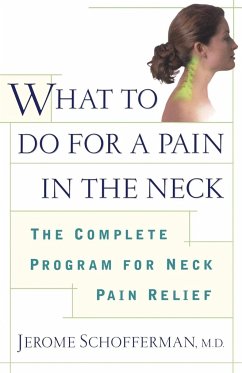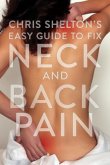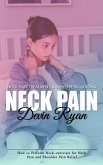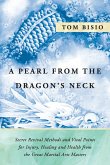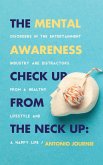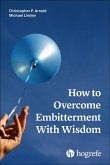Kit Laughlin
Overcome Neck & Back Pain
21,99 €
inkl. MwSt.
Versandfertig in 1-2 Wochen

11 °P sammeln
Kit Laughlin
Overcome Neck & Back Pain
- Broschiertes Buch
- Merkliste
- Auf die Merkliste
- Bewerten Bewerten
- Teilen
- Produkt teilen
- Produkterinnerung
- Produkterinnerung
If you suffer from back pain, as 85 percent of Americans do, you may think there is no way to bring about a complete end to your pain. Books, videos, and even doctors offer ways to manage the pain, but not to stop it. Finally there is a solution. Overcome Neck & Back Pain, the international bestseller, provides a means to end your back pain permanently through an easy-to-follow four-part program of structural analysis and correction, stretching, strengthening, and relaxing. Kit Laughlin spent years suffering from back pain, and, in search of relief, even traveled to Japan, where he found the…mehr
Andere Kunden interessierten sich auch für
![What to Do for a Pain in the Neck What to Do for a Pain in the Neck]() Jerome SchoffermanWhat to Do for a Pain in the Neck19,99 €
Jerome SchoffermanWhat to Do for a Pain in the Neck19,99 €![Chris Shelton's Easy Guide to Fix Neck and Back Pain Chris Shelton's Easy Guide to Fix Neck and Back Pain]() Chris SheltonChris Shelton's Easy Guide to Fix Neck and Back Pain27,99 €
Chris SheltonChris Shelton's Easy Guide to Fix Neck and Back Pain27,99 €![Neck Pain Neck Pain]() Devin RyanNeck Pain17,99 €
Devin RyanNeck Pain17,99 €![A Pearl from the Dragon's Neck A Pearl from the Dragon's Neck]() Tom BisioA Pearl from the Dragon's Neck25,99 €
Tom BisioA Pearl from the Dragon's Neck25,99 €![The Mental Awareness Check Up From The Neck Up The Mental Awareness Check Up From The Neck Up]() Antonio JournieThe Mental Awareness Check Up From The Neck Up24,99 €
Antonio JournieThe Mental Awareness Check Up From The Neck Up24,99 €![How to Overcome Embitterment With Wisdom How to Overcome Embitterment With Wisdom]() Christopher Patrick ArnoldHow to Overcome Embitterment With Wisdom11,99 €
Christopher Patrick ArnoldHow to Overcome Embitterment With Wisdom11,99 €![Overcome Dandruff And Other Scalp Issues Overcome Dandruff And Other Scalp Issues]() Janine FrazierOvercome Dandruff And Other Scalp Issues21,99 €
Janine FrazierOvercome Dandruff And Other Scalp Issues21,99 €-
-
-
If you suffer from back pain, as 85 percent of Americans do, you may think there is no way to bring about a complete end to your pain. Books, videos, and even doctors offer ways to manage the pain, but not to stop it. Finally there is a solution. Overcome Neck & Back Pain, the international bestseller, provides a means to end your back pain permanently through an easy-to-follow four-part program of structural analysis and correction, stretching, strengthening, and relaxing. Kit Laughlin spent years suffering from back pain, and, in search of relief, even traveled to Japan, where he found the solution. Using the principles of hatha yoga, he developed a combination of Eastern and Western medicine that provides a way to stop back pain and even protect oneself from future injury. Through clear, instructive photos and easy-to-follow instructions Overcome Neck & Back Pain shows the beginner how to use stretching, strengthening, and relaxation to end the pain. Overcome Neck & Back Pain also provides instruction in more advanced techniques, with an explanation of the principles behind the movements. The comprehensive text offers solutions for athletes and nonathletes, old and young alike. If you've given up hope of curing your back pain, Overcome Neck & Back Pain provides the sensible solution you need.
Hinweis: Dieser Artikel kann nur an eine deutsche Lieferadresse ausgeliefert werden.
Hinweis: Dieser Artikel kann nur an eine deutsche Lieferadresse ausgeliefert werden.
Produktdetails
- Produktdetails
- Verlag: Fireside
- Seitenzahl: 210
- Erscheinungstermin: 1. Dezember 1998
- Englisch
- Abmessung: 280mm x 210mm x 12mm
- Gewicht: 527g
- ISBN-13: 9780684852522
- ISBN-10: 0684852527
- Artikelnr.: 21900762
- Herstellerkennzeichnung
- Libri GmbH
- Europaallee 1
- 36244 Bad Hersfeld
- gpsr@libri.de
- Verlag: Fireside
- Seitenzahl: 210
- Erscheinungstermin: 1. Dezember 1998
- Englisch
- Abmessung: 280mm x 210mm x 12mm
- Gewicht: 527g
- ISBN-13: 9780684852522
- ISBN-10: 0684852527
- Artikelnr.: 21900762
- Herstellerkennzeichnung
- Libri GmbH
- Europaallee 1
- 36244 Bad Hersfeld
- gpsr@libri.de
Kit Laughlin studied oriental medicine during a five-year stay in Japan and, on his return to Australia, was the Japanese ambassador's personal shiatsu practitioner. In 1988 he was asked to treat the prime minister of Japan during his visit to Australia, the first time a Westerner had been asked to provide such a service. Laughlin was awarded a Master of Letters degree in 1992 from the Science Faculty of the Australian National University, and currently is doing research for a Ph.D. dissertation in which back pain is the key case study. Laughlin originated the Posture & Flexibility and Strength & Flexibility courses that have been run by the Australian National University Sports Union for the last eleven years. Assisted by fourteen teachers whom he trained, Laughlin has taught these courses to thousands of students of all ages and levels of fitness, with proven results. He is the presenter of the acclaimed Overcome Neck & Back Pain seminars and the author of a forthcoming book, Introduction to Posture & Flexibility.
CONTENTS
ILLUSTRATIONS
PREFACE
WHY THE INTEREST IN NECK AND BACK PAIN?
What is this book about?
What can I do?
Who should use this book?
How this book is set out
Cautions
INTRODUCTION
BACKGROUND TO THE APPROACH
Shoshin Center
Case studies from the clinic
Posture & Flexibility at the Australian National University
Contact address and e-mail
CHAPTER ONE
SELF-DIAGNOSIS
What is covered in this chapter?
Pelvic obliquity
How to determine if you have one hip lower than the other
i) one hip is lifted higher than the other
ii) both hips are lifted by the test, but one higher than the other
iii) both hips are lifted about the same
The heel insert
How thick should the insert be?
What if I make a mistake?
Other indicators of pelvic obliquity
How to determine whether muscular causes of problems like sciatica
are present
How to determine your patterns of muscular tension
FLOW CHART FOR TESTING MUSCLE IMBALANCES
TEST AND EXERCISE CHECK LIST
How often should I stretch?
The general principles of good stretching, at a glance:
CHAPTER TWO
REHABILITATION STRETCHING EXERCISES
Limits
Static stretching
Ballistic stretching
The Posture & Flexibility approach to stretching
How to breathe
Benefits of warmth
Why photographs?
REHABILITATION
LOWER BACK EXERCISES
1. Seated forward bend
2. Seated side bend and rotation
3. Lying rotation
4. Partner-assisted lying rotation
5. Buttock and hip flexor
6. Seated hip
7. Lying hip
8. Table-top hip
9. Hip flexors
10. Trunk side bending
11. Hamstrings
MIDDLE BACK EXERCISES
12. Seated rotation
13. Upper back on all fours
14. Middle and upper back
NECK EXERCISES
15. Partner shoulder depress
16. Chin to chest
17. Neck side bend
18. Neck forward and side bend
19. Neck backward and side bend
20. Neck rotation
21. Chin-to-chest variations
CHAPTER THREE
PREVENTION
22. Advanced forward bend
23. Advanced forward and side bend
24. Advanced rotation
25. Advanced buttock and hip flexors
26. External hip rotator (piriformis)
27. Front thigh (quadriceps)
28. Backward bend over support
29. Backward bend from floor
30. Standing calf
31. Standing side bend
32. Lying side bend
33. Middle and upper back backward bend
STRENGTHENING EXERCISES
Matching training to expected demand
34. Abdominal curl
35. Abdominal curl over support
36. Back uncurl
37. Trunk rotation
38. Trunk rotation with weight
ADVANCED STRENGTHENING EXERCISE (PREVENTION)
39. Knee lift
PLANNING A TOTAL ROUTINE
Frequency of exercise
Sets and reps
Working habits
Speed of movements
The importance of rest
The place of aerobic exercise
Lifting things in everyday life
The daily six
For low back pain
For middle back pain
For upper back and neck pain
For wbole-body suppleness
Pointers to chapter four, causes, and chapter five, relaxation
techniques
CHAPTER FOUR
THE CAUSES OF NECK AND BACK PAIN
Why do we suffer back pain?
Chiropractic and osteopathy
Oriental medicine
Acute pain
Chronic pain
Muscle tension as cause
Other factors contributing to neck and back pain
What is good posture?
Tests of leg-length inequality
What effects can uneven hips have on the body?
How thick should my heel lift be?
Is right- or left-handedness related to the problem?
Adding another layer to the argument
Shortcomings with the idea of cause
Workshop experiences
Choice of bed
CHAPTER FIVE
RELAXATION TECHNIQUES
Practical Stress Management seminars
Why relax?
Relaxation method
Guided visualization and healing the body
A script for relaxation and visualization
ACKNOWLEDGMENTS
REFERENCES
Further reading (annotated)
QUICK REFERENCE
ILLUSTRATIONS
Heel insert
Where am I sore?
The Contract-Relax (C-R) approach to stretching
Muscles stretched in exercise 1
Right hip in the intermediate position showing stretched muscles in
exercise 5
Three ways the sciatic nerve may exit the pelvis
Psoas, iliacus (iliopsoas), and quadratus lumborum
Exaggerated lumbar curve caused by tight iliopsoas
Schematic showing quadratus lumborum, as stretched in exercise 10
Hamstring muscle from side; biceps femoris
The three hamstring muscles
Levator scapulae, and detail of suboccipitals
Front and side neck muscles
Possible entrapment of nerves by scalene muscles
Muscles of the front and inside of the leg
Muscles of the lower leg
Sciatic nerve runs down back of leg
Schematic of hip muscles affected in exercise 31
Upper body muscles, and changes accompanying aging
Why the conventional situp can injure the lower back
Class II lever
Exercise 36 strengthens the trunk in the necessary range of movement
Correct form in exercise 37
One theory of back weakness
The three curves of the spinal column act as a shock absorber
Schematic of spine, vertebral bodies and disc
Posterolateral (back-side) extrusion of intervertebral disc impinging
on nerve root
Schematic showing significance of leg-length difference
Schematic of good posture
Effects of pelvic obliquity on the shape of spine
Simple model of possible effects of leg-length difference
Schematic of rowing
As leg extends, hip joint ligaments tighten around neck of femur
ILLUSTRATIONS
PREFACE
WHY THE INTEREST IN NECK AND BACK PAIN?
What is this book about?
What can I do?
Who should use this book?
How this book is set out
Cautions
INTRODUCTION
BACKGROUND TO THE APPROACH
Shoshin Center
Case studies from the clinic
Posture & Flexibility at the Australian National University
Contact address and e-mail
CHAPTER ONE
SELF-DIAGNOSIS
What is covered in this chapter?
Pelvic obliquity
How to determine if you have one hip lower than the other
i) one hip is lifted higher than the other
ii) both hips are lifted by the test, but one higher than the other
iii) both hips are lifted about the same
The heel insert
How thick should the insert be?
What if I make a mistake?
Other indicators of pelvic obliquity
How to determine whether muscular causes of problems like sciatica
are present
How to determine your patterns of muscular tension
FLOW CHART FOR TESTING MUSCLE IMBALANCES
TEST AND EXERCISE CHECK LIST
How often should I stretch?
The general principles of good stretching, at a glance:
CHAPTER TWO
REHABILITATION STRETCHING EXERCISES
Limits
Static stretching
Ballistic stretching
The Posture & Flexibility approach to stretching
How to breathe
Benefits of warmth
Why photographs?
REHABILITATION
LOWER BACK EXERCISES
1. Seated forward bend
2. Seated side bend and rotation
3. Lying rotation
4. Partner-assisted lying rotation
5. Buttock and hip flexor
6. Seated hip
7. Lying hip
8. Table-top hip
9. Hip flexors
10. Trunk side bending
11. Hamstrings
MIDDLE BACK EXERCISES
12. Seated rotation
13. Upper back on all fours
14. Middle and upper back
NECK EXERCISES
15. Partner shoulder depress
16. Chin to chest
17. Neck side bend
18. Neck forward and side bend
19. Neck backward and side bend
20. Neck rotation
21. Chin-to-chest variations
CHAPTER THREE
PREVENTION
22. Advanced forward bend
23. Advanced forward and side bend
24. Advanced rotation
25. Advanced buttock and hip flexors
26. External hip rotator (piriformis)
27. Front thigh (quadriceps)
28. Backward bend over support
29. Backward bend from floor
30. Standing calf
31. Standing side bend
32. Lying side bend
33. Middle and upper back backward bend
STRENGTHENING EXERCISES
Matching training to expected demand
34. Abdominal curl
35. Abdominal curl over support
36. Back uncurl
37. Trunk rotation
38. Trunk rotation with weight
ADVANCED STRENGTHENING EXERCISE (PREVENTION)
39. Knee lift
PLANNING A TOTAL ROUTINE
Frequency of exercise
Sets and reps
Working habits
Speed of movements
The importance of rest
The place of aerobic exercise
Lifting things in everyday life
The daily six
For low back pain
For middle back pain
For upper back and neck pain
For wbole-body suppleness
Pointers to chapter four, causes, and chapter five, relaxation
techniques
CHAPTER FOUR
THE CAUSES OF NECK AND BACK PAIN
Why do we suffer back pain?
Chiropractic and osteopathy
Oriental medicine
Acute pain
Chronic pain
Muscle tension as cause
Other factors contributing to neck and back pain
What is good posture?
Tests of leg-length inequality
What effects can uneven hips have on the body?
How thick should my heel lift be?
Is right- or left-handedness related to the problem?
Adding another layer to the argument
Shortcomings with the idea of cause
Workshop experiences
Choice of bed
CHAPTER FIVE
RELAXATION TECHNIQUES
Practical Stress Management seminars
Why relax?
Relaxation method
Guided visualization and healing the body
A script for relaxation and visualization
ACKNOWLEDGMENTS
REFERENCES
Further reading (annotated)
QUICK REFERENCE
ILLUSTRATIONS
Heel insert
Where am I sore?
The Contract-Relax (C-R) approach to stretching
Muscles stretched in exercise 1
Right hip in the intermediate position showing stretched muscles in
exercise 5
Three ways the sciatic nerve may exit the pelvis
Psoas, iliacus (iliopsoas), and quadratus lumborum
Exaggerated lumbar curve caused by tight iliopsoas
Schematic showing quadratus lumborum, as stretched in exercise 10
Hamstring muscle from side; biceps femoris
The three hamstring muscles
Levator scapulae, and detail of suboccipitals
Front and side neck muscles
Possible entrapment of nerves by scalene muscles
Muscles of the front and inside of the leg
Muscles of the lower leg
Sciatic nerve runs down back of leg
Schematic of hip muscles affected in exercise 31
Upper body muscles, and changes accompanying aging
Why the conventional situp can injure the lower back
Class II lever
Exercise 36 strengthens the trunk in the necessary range of movement
Correct form in exercise 37
One theory of back weakness
The three curves of the spinal column act as a shock absorber
Schematic of spine, vertebral bodies and disc
Posterolateral (back-side) extrusion of intervertebral disc impinging
on nerve root
Schematic showing significance of leg-length difference
Schematic of good posture
Effects of pelvic obliquity on the shape of spine
Simple model of possible effects of leg-length difference
Schematic of rowing
As leg extends, hip joint ligaments tighten around neck of femur
CONTENTS
ILLUSTRATIONS
PREFACE
WHY THE INTEREST IN NECK AND BACK PAIN?
What is this book about?
What can I do?
Who should use this book?
How this book is set out
Cautions
INTRODUCTION
BACKGROUND TO THE APPROACH
Shoshin Center
Case studies from the clinic
Posture & Flexibility at the Australian National University
Contact address and e-mail
CHAPTER ONE
SELF-DIAGNOSIS
What is covered in this chapter?
Pelvic obliquity
How to determine if you have one hip lower than the other
i) one hip is lifted higher than the other
ii) both hips are lifted by the test, but one higher than the other
iii) both hips are lifted about the same
The heel insert
How thick should the insert be?
What if I make a mistake?
Other indicators of pelvic obliquity
How to determine whether muscular causes of problems like sciatica
are present
How to determine your patterns of muscular tension
FLOW CHART FOR TESTING MUSCLE IMBALANCES
TEST AND EXERCISE CHECK LIST
How often should I stretch?
The general principles of good stretching, at a glance:
CHAPTER TWO
REHABILITATION STRETCHING EXERCISES
Limits
Static stretching
Ballistic stretching
The Posture & Flexibility approach to stretching
How to breathe
Benefits of warmth
Why photographs?
REHABILITATION
LOWER BACK EXERCISES
1. Seated forward bend
2. Seated side bend and rotation
3. Lying rotation
4. Partner-assisted lying rotation
5. Buttock and hip flexor
6. Seated hip
7. Lying hip
8. Table-top hip
9. Hip flexors
10. Trunk side bending
11. Hamstrings
MIDDLE BACK EXERCISES
12. Seated rotation
13. Upper back on all fours
14. Middle and upper back
NECK EXERCISES
15. Partner shoulder depress
16. Chin to chest
17. Neck side bend
18. Neck forward and side bend
19. Neck backward and side bend
20. Neck rotation
21. Chin-to-chest variations
CHAPTER THREE
PREVENTION
22. Advanced forward bend
23. Advanced forward and side bend
24. Advanced rotation
25. Advanced buttock and hip flexors
26. External hip rotator (piriformis)
27. Front thigh (quadriceps)
28. Backward bend over support
29. Backward bend from floor
30. Standing calf
31. Standing side bend
32. Lying side bend
33. Middle and upper back backward bend
STRENGTHENING EXERCISES
Matching training to expected demand
34. Abdominal curl
35. Abdominal curl over support
36. Back uncurl
37. Trunk rotation
38. Trunk rotation with weight
ADVANCED STRENGTHENING EXERCISE (PREVENTION)
39. Knee lift
PLANNING A TOTAL ROUTINE
Frequency of exercise
Sets and reps
Working habits
Speed of movements
The importance of rest
The place of aerobic exercise
Lifting things in everyday life
The daily six
For low back pain
For middle back pain
For upper back and neck pain
For wbole-body suppleness
Pointers to chapter four, causes, and chapter five, relaxation
techniques
CHAPTER FOUR
THE CAUSES OF NECK AND BACK PAIN
Why do we suffer back pain?
Chiropractic and osteopathy
Oriental medicine
Acute pain
Chronic pain
Muscle tension as cause
Other factors contributing to neck and back pain
What is good posture?
Tests of leg-length inequality
What effects can uneven hips have on the body?
How thick should my heel lift be?
Is right- or left-handedness related to the problem?
Adding another layer to the argument
Shortcomings with the idea of cause
Workshop experiences
Choice of bed
CHAPTER FIVE
RELAXATION TECHNIQUES
Practical Stress Management seminars
Why relax?
Relaxation method
Guided visualization and healing the body
A script for relaxation and visualization
ACKNOWLEDGMENTS
REFERENCES
Further reading (annotated)
QUICK REFERENCE
ILLUSTRATIONS
Heel insert
Where am I sore?
The Contract-Relax (C-R) approach to stretching
Muscles stretched in exercise 1
Right hip in the intermediate position showing stretched muscles in
exercise 5
Three ways the sciatic nerve may exit the pelvis
Psoas, iliacus (iliopsoas), and quadratus lumborum
Exaggerated lumbar curve caused by tight iliopsoas
Schematic showing quadratus lumborum, as stretched in exercise 10
Hamstring muscle from side; biceps femoris
The three hamstring muscles
Levator scapulae, and detail of suboccipitals
Front and side neck muscles
Possible entrapment of nerves by scalene muscles
Muscles of the front and inside of the leg
Muscles of the lower leg
Sciatic nerve runs down back of leg
Schematic of hip muscles affected in exercise 31
Upper body muscles, and changes accompanying aging
Why the conventional situp can injure the lower back
Class II lever
Exercise 36 strengthens the trunk in the necessary range of movement
Correct form in exercise 37
One theory of back weakness
The three curves of the spinal column act as a shock absorber
Schematic of spine, vertebral bodies and disc
Posterolateral (back-side) extrusion of intervertebral disc impinging
on nerve root
Schematic showing significance of leg-length difference
Schematic of good posture
Effects of pelvic obliquity on the shape of spine
Simple model of possible effects of leg-length difference
Schematic of rowing
As leg extends, hip joint ligaments tighten around neck of femur
ILLUSTRATIONS
PREFACE
WHY THE INTEREST IN NECK AND BACK PAIN?
What is this book about?
What can I do?
Who should use this book?
How this book is set out
Cautions
INTRODUCTION
BACKGROUND TO THE APPROACH
Shoshin Center
Case studies from the clinic
Posture & Flexibility at the Australian National University
Contact address and e-mail
CHAPTER ONE
SELF-DIAGNOSIS
What is covered in this chapter?
Pelvic obliquity
How to determine if you have one hip lower than the other
i) one hip is lifted higher than the other
ii) both hips are lifted by the test, but one higher than the other
iii) both hips are lifted about the same
The heel insert
How thick should the insert be?
What if I make a mistake?
Other indicators of pelvic obliquity
How to determine whether muscular causes of problems like sciatica
are present
How to determine your patterns of muscular tension
FLOW CHART FOR TESTING MUSCLE IMBALANCES
TEST AND EXERCISE CHECK LIST
How often should I stretch?
The general principles of good stretching, at a glance:
CHAPTER TWO
REHABILITATION STRETCHING EXERCISES
Limits
Static stretching
Ballistic stretching
The Posture & Flexibility approach to stretching
How to breathe
Benefits of warmth
Why photographs?
REHABILITATION
LOWER BACK EXERCISES
1. Seated forward bend
2. Seated side bend and rotation
3. Lying rotation
4. Partner-assisted lying rotation
5. Buttock and hip flexor
6. Seated hip
7. Lying hip
8. Table-top hip
9. Hip flexors
10. Trunk side bending
11. Hamstrings
MIDDLE BACK EXERCISES
12. Seated rotation
13. Upper back on all fours
14. Middle and upper back
NECK EXERCISES
15. Partner shoulder depress
16. Chin to chest
17. Neck side bend
18. Neck forward and side bend
19. Neck backward and side bend
20. Neck rotation
21. Chin-to-chest variations
CHAPTER THREE
PREVENTION
22. Advanced forward bend
23. Advanced forward and side bend
24. Advanced rotation
25. Advanced buttock and hip flexors
26. External hip rotator (piriformis)
27. Front thigh (quadriceps)
28. Backward bend over support
29. Backward bend from floor
30. Standing calf
31. Standing side bend
32. Lying side bend
33. Middle and upper back backward bend
STRENGTHENING EXERCISES
Matching training to expected demand
34. Abdominal curl
35. Abdominal curl over support
36. Back uncurl
37. Trunk rotation
38. Trunk rotation with weight
ADVANCED STRENGTHENING EXERCISE (PREVENTION)
39. Knee lift
PLANNING A TOTAL ROUTINE
Frequency of exercise
Sets and reps
Working habits
Speed of movements
The importance of rest
The place of aerobic exercise
Lifting things in everyday life
The daily six
For low back pain
For middle back pain
For upper back and neck pain
For wbole-body suppleness
Pointers to chapter four, causes, and chapter five, relaxation
techniques
CHAPTER FOUR
THE CAUSES OF NECK AND BACK PAIN
Why do we suffer back pain?
Chiropractic and osteopathy
Oriental medicine
Acute pain
Chronic pain
Muscle tension as cause
Other factors contributing to neck and back pain
What is good posture?
Tests of leg-length inequality
What effects can uneven hips have on the body?
How thick should my heel lift be?
Is right- or left-handedness related to the problem?
Adding another layer to the argument
Shortcomings with the idea of cause
Workshop experiences
Choice of bed
CHAPTER FIVE
RELAXATION TECHNIQUES
Practical Stress Management seminars
Why relax?
Relaxation method
Guided visualization and healing the body
A script for relaxation and visualization
ACKNOWLEDGMENTS
REFERENCES
Further reading (annotated)
QUICK REFERENCE
ILLUSTRATIONS
Heel insert
Where am I sore?
The Contract-Relax (C-R) approach to stretching
Muscles stretched in exercise 1
Right hip in the intermediate position showing stretched muscles in
exercise 5
Three ways the sciatic nerve may exit the pelvis
Psoas, iliacus (iliopsoas), and quadratus lumborum
Exaggerated lumbar curve caused by tight iliopsoas
Schematic showing quadratus lumborum, as stretched in exercise 10
Hamstring muscle from side; biceps femoris
The three hamstring muscles
Levator scapulae, and detail of suboccipitals
Front and side neck muscles
Possible entrapment of nerves by scalene muscles
Muscles of the front and inside of the leg
Muscles of the lower leg
Sciatic nerve runs down back of leg
Schematic of hip muscles affected in exercise 31
Upper body muscles, and changes accompanying aging
Why the conventional situp can injure the lower back
Class II lever
Exercise 36 strengthens the trunk in the necessary range of movement
Correct form in exercise 37
One theory of back weakness
The three curves of the spinal column act as a shock absorber
Schematic of spine, vertebral bodies and disc
Posterolateral (back-side) extrusion of intervertebral disc impinging
on nerve root
Schematic showing significance of leg-length difference
Schematic of good posture
Effects of pelvic obliquity on the shape of spine
Simple model of possible effects of leg-length difference
Schematic of rowing
As leg extends, hip joint ligaments tighten around neck of femur
